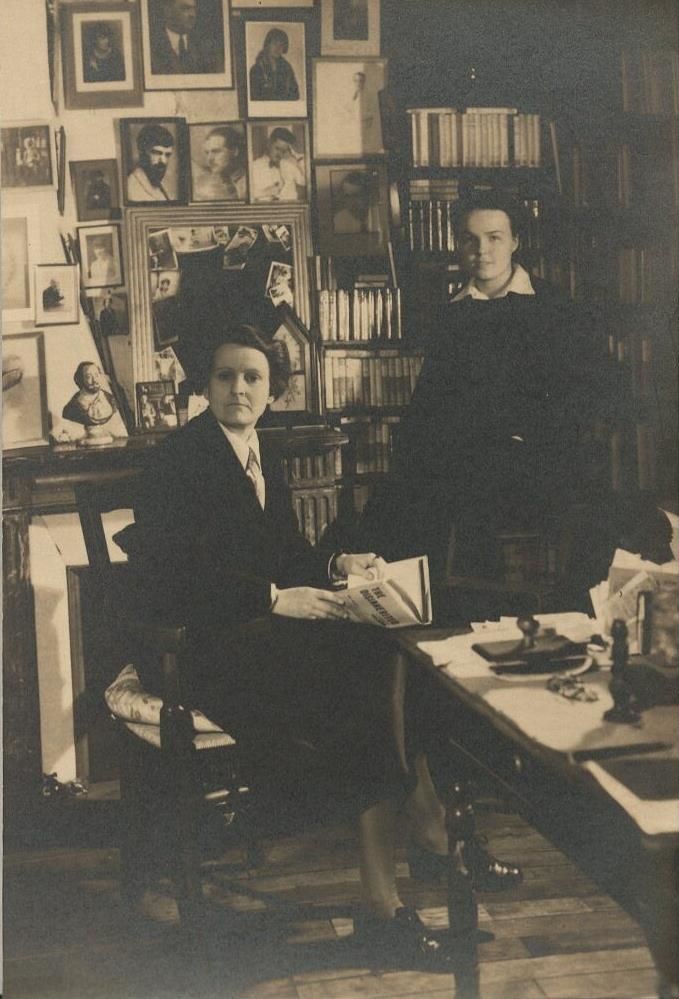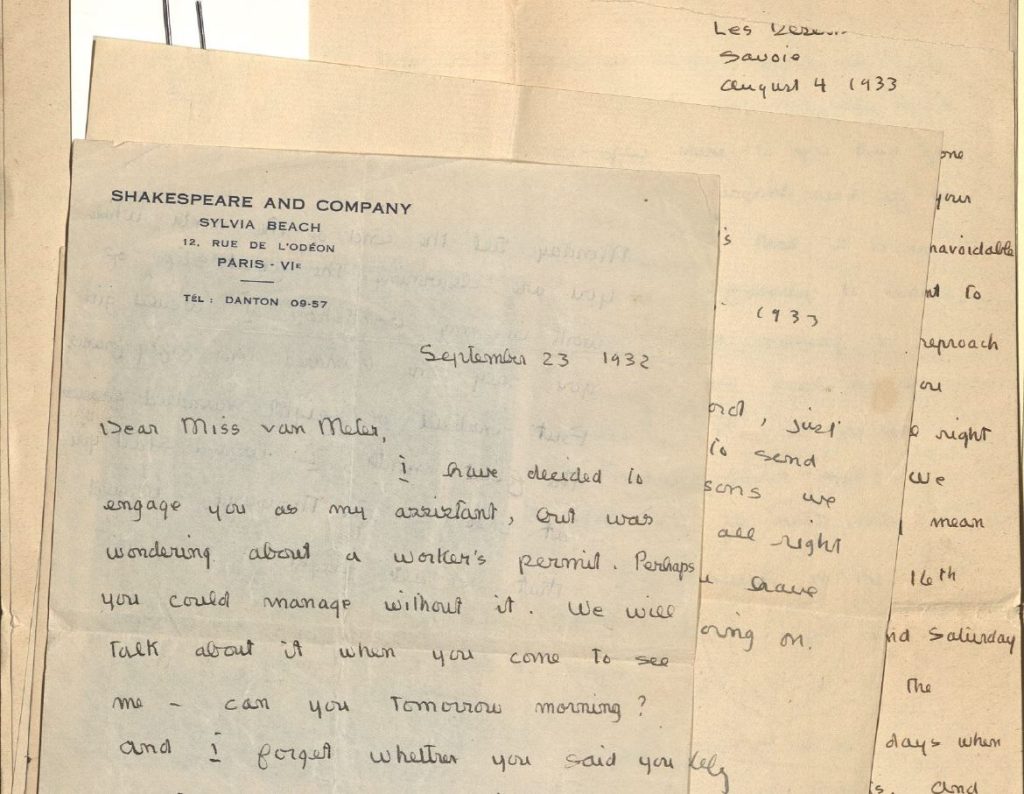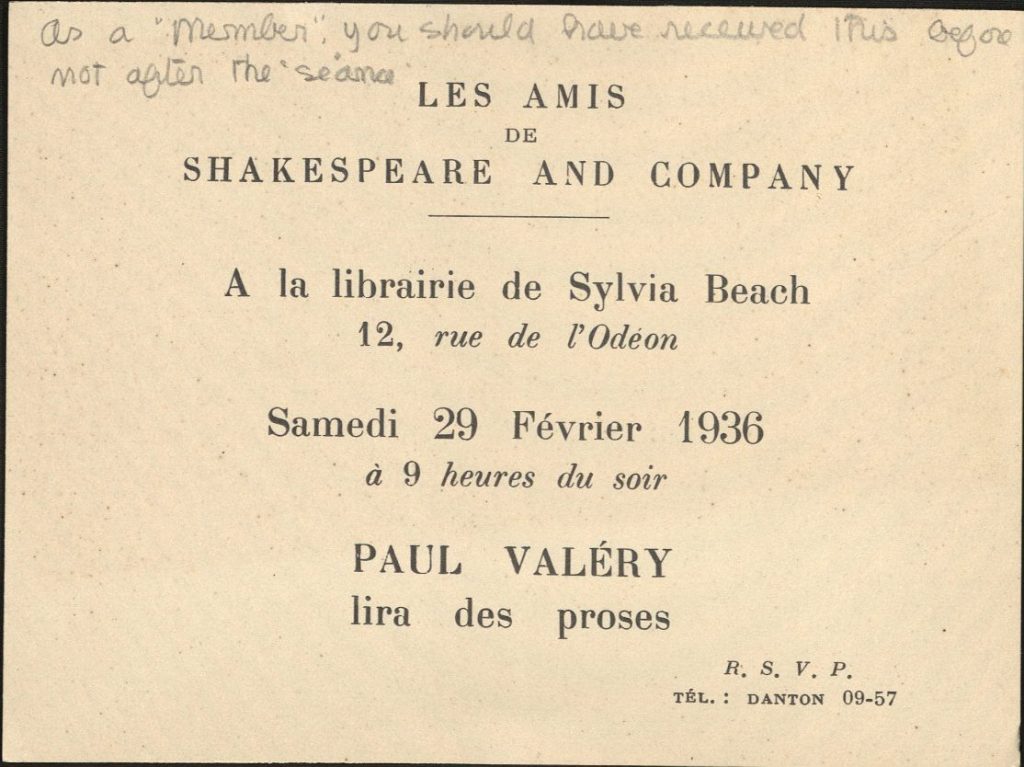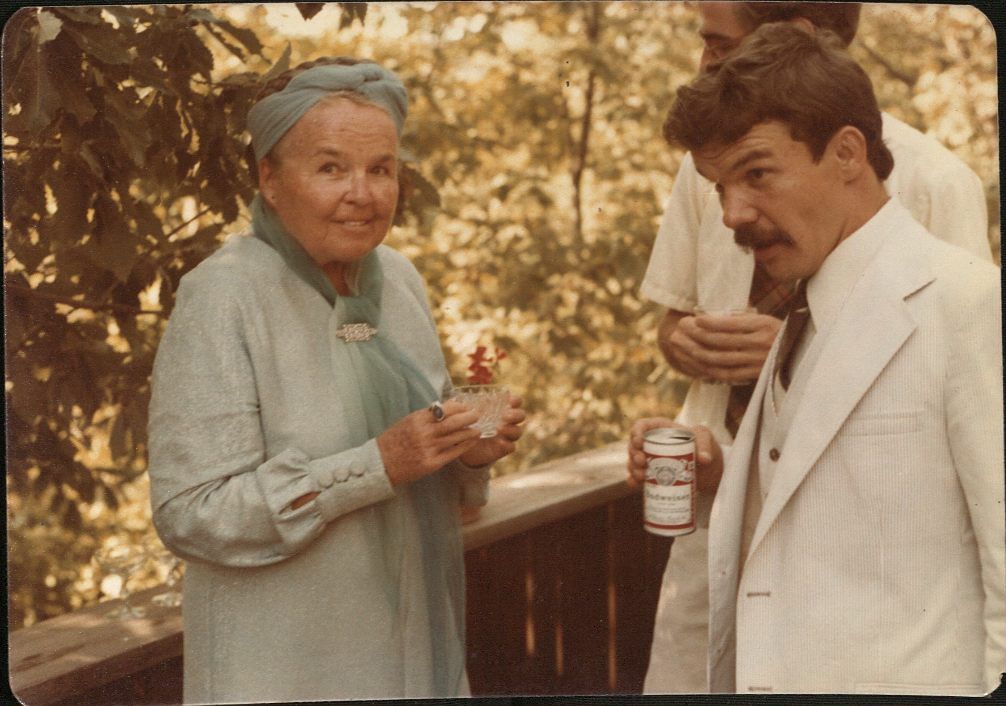Bloomsday 2025: Sylvia Beach and Jane van Meter
June 15th, 2025This Monday is “Bloomsday,” an annual celebration of the day (June 16, 1904) on which James Joyce’s novel Ulysses is set. “Bloomsday” takes its name from one of the book’s central characters, Leopold Bloom, and each June 16th fans of Joyce and Ulysses often celebrate with marathon readings of the novel and other events. In honor of Bloomsday 2025, we’re highlighting a figure without whom Ulysses might not have been published—Sylvia Beach (1887-1962)—and Beach’s connection to an equally-interesting (though less well-known) Lawrence resident, Jane van Meter (1906-1992).

As those well-versed in lore surrounding Ulysses will know, Sylvia Beach was an American living in Paris who ran a bookshop and lending library named Shakespeare and Company. The bookshop served as a hub for expatriate literary life on Paris’s Left Bank during the years between the two world wars. It was Beach and Shakespeare and Company who published Ulysses in 1922. Beach had stepped in following the obscenity case in New York courts which saw the editors of The Little Review fined for the magazine’s serialization of episodes from Ulysses. This ruling left publishers, including Joyce’s US publisher Huebsch, wary of the legal troubles and financial risks involved in publishing a novel that would likely be seized before its costs could be recouped in sales. Though not normally a publisher, Beach, working in the more permissive publishing environment of France, volunteered to take on the task in order to champion a writer and a novel she admired.
To help offset the costs of production, Shakespeare and Company sold copies of Ulysses by subscription in advance of its printing, offering the novel in three different paper formats at different price points (350, 250, and 150 Francs). Of the 1000 copies of first edition of Ulysses, Spencer Research Library holds examples of all three different paper issues (four copies in total), including the scarcest issue, which was numbered from 1-100 on Dutch handmade paper and signed by Joyce.
Much has been written about the publication history of Ulysses, so we won’t re-tread that ground here, and instead we’ll turn to a Lawrence figure with deep ties to Beach and Shakespeare and Company: Jane van Meter. Van Meter moved to Lawrence in 1960 with her then husband, the Shakespearean scholar, Charlton Hinman. Though the couple later divorced, van Meter remained in Lawrence until her death in 1992. She was a memorable figure on campus, known by some as “the Blue Lady,” for her habit of always wearing a powder blue outfit.[1] Before her marriage, however, van Meter had worked as an assistant to Sylvia Beach at Shakespeare and Company. Hired in 1932, ten years after the publication of Ulysses, van Meter nevertheless found herself amidst the various writers still living in and passing through Paris, including Joyce.

At the shop, van Meter quickly made herself an indispensable and highly trusted employee. In her memoir, Shakespeare and Company, Beach wrote of her, “The first and only really professional assistant I ever had was Miss Jane van Meter […]. I had put an ad in the Paris Herald Tribune, and Miss van Meter answered it. I couldn’t wish anybody better luck than to have her as an assistant.”[2] As the correspondence now housed at Spencer Library shows, van Meter was even trusted to handle operations of the bookstore and lending library while Beach traveled to Savoie for the summer with her partner, Adrienne Monnier, who ran a French language bookshop/lending library, La Maison des Amis des Livres, across the street on the rue de l’Odéon. After van Meter left Paris and the job in late 1935, Beach continued to write to her, often updating her, especially in the early years, on goings on in and around the bookstore. In a March 6th, 1936 letter, Beach was clearly feeling the loss of her right-hand woman, writing to van Meter, “You are still and always will be a part of the Firm [i.e. Shakespeare and Company] and one of the best friends I ever had. And I miss you so.” Beach then continues by outlining some of the shortcomings of the woman helping out in van Meter’s absence:
…she has done her best (or worst) to help me but there is nothing on which we see ‘eye-to-eye.’ You ought to hear her disparaging remarks about the ‘seances’ which everyone else has found so interesting. She says “living is better than to bury ones nose in silly stuffy books” etc., that [French writer] Jules Romain (looking at his portrait) has an ignoble mouth and his eyes give one an impression that he is positively ‘louche’; that Joyce’s head is terrifying, and that she doesn’t see why Adrienne and I treated [André] Gide with such respect when he came one day to talk about his reading and where he was to sit. So we shall soon have to part. […]

In the same letter, Beach also reports on the various literary goings on around the shop, including readings at Shakespeare and Company by the French writers André Gide (February 1st) and Paul Valéry (February 29th), with James Joyce in attendance:
Jane I wish you could have been here for Gide and Valéry! They went off beautifully, as Agnes has probably told you. Gide read passages from his next novel Geneviève in a remarkable way, in spite of a bad cold and chills & fever from which he complained he was suffering. […] And Valéry read some fascinating unpublished prose pieces on the alphabet, and ‘Narcisse’ – then at Joyce’s request, ‘Le serpent.’ It was so fine – everybody was carried away by it. The Paulhans were there, and the Churches and a M. Lu[??]gneaux director of the TSF, and Destin & Clive Bell, and Joyce brought his son Georgio [sic] and his wife, and Carlotta sat with the Valéry family who was ‘au complet’ but he had asked them not to sit where he could see them – he had seen them so often he couldn’t read with them in front of him, which amused them very much. They came to hear Gide too, also Joyce. These readings, in spite of having to move all of the furniture out of the shop every time, are really interesting and a pleasure. I think you would have enjoyed them.

The more than 80 letters from Beach in the van Meter collection are often full of such fascinating details of writers, literature, and Paris life. Many of Sylvia Beach’s letters to van Meter are from the 1930s and 1940s, but the two women continued to correspond into the 1950s, even sending books and other gifts to one another from time to time. Shakespeare and Company closed in 1941, during the German occupation, though Adrienne Monnier’s La Maison des Amis des Livres remained in business until 1951. The collection includes a letter, dated October 22, 1955 (MS 383, Box 1, Folder 29), that Beach sent discussing Monnier’s death:
I don’t know whether you have heard the news of Adrienne’s death in June. My sister who lives in Greenwich, as you know, was making me a visit [in Paris] at the time. Adrienne suffered dreadfully. I am glad that it is over. But no use in trying to be happy without Adrienne, as you know. […]
It was a profound loss for Beach; the couple had been together for over 35 years. Monnier killed herself after being in poor health for some time, including a 1954 diagnosis of Ménière’s disease, which was (and remains) incurable. The last dated letter from Beach to van Meter in the collection is from November of 1955, however they must have continued to correspond beyond that since van Meter’s collection includes a copy of Les années vingt: les écrivains Américains a Paris et leurs amis, published in 1959, that is inscribed “For Jane with love from Shakespeare and Company, Sylvia.” Beach died in Paris in 1962, and her papers are housed at Princeton University. Van Meter’s care in preserving Beach’s letters and materials related to her studies in France suggest the importance that period held for her.
The story of how these materials came to be housed at Spencer Research Library is an interesting one, too. In 1967, Jane van Meter met Wayne Propst at the Kansas Union while he was a student at KU. Despite their age difference, the two developed a long-running friendship, and Propst helped to care for van Meter in her later years. Propst, a writer and artist (and a countercultural figure around Lawrence in his own right), recently published a remembrance of van Meter in the volume Embattled Lawrence Kansas: The Enduring Struggle for Freedom (2022). Materials used for this piece also appear in the collection.

It is thanks to Propst that Spencer Research Library houses Sylvia Beach’s letters to Jane van Meter. Propst donated them, alongside other materials related to Jane van Meter’s time in France, to the library on June 16th (Bloomsday), 2022. It is only fitting, then, that we celebrate Bloomsday 2025 by highlighting the correspondence of two women, Sylvia Beach and Jane van Meter, who had been at the center of literary life on Paris’s Left Bank during the interwar years.
Want to learn more?
- Visit Spencer Research Library and explore the Jane van Meter Collection (MS 383)
- Read Sylvia Beach’s account of the publication of Ulysses (1922) and other stories of Paris life in her memoir, Shakespeare and Company (1959). Copies are available at Spencer Research Library and in KU’s circulating Collections.
- Read Wayne Propst’s piece on Jane van Meter in Embattled Lawrence Kansas: The Enduring Struggle for Freedom (2022), edited by Dennis Domer. The volume includes articles outlining different and overlooked aspects of Lawrence’s history by various authors, including current and retired KU faculty and staff.
- Read works by Wayne S. Propst in Spencer Research Library’s collections.
- Check out two past Bloomsday Spencer Research Library blog posts from 2012 and 2013.
Elspeth Healey
Special Collections Curator
[1] Indeed, van Meter was featured in a 2019 UDK article by Liam Mays titled “5 Lawrence legends from ‘Tan Man’ to ‘White Owl:’ Names that stand the test of time”: https://www.kansan.com/arts_and_culture/5-lawrence-legends-from-tan-man-to-white-owl-names-that-stand-the-test-of/article_274676c0-12df-11ea-a220-735c1d0bde70.html, though some of the details about Van Meter in the article are more accurate than others.
[2] Beach, Sylvia. Shakespeare and Company. New York: Harcourt, Brace, [1959]: 209. Call #: Joyce Y316.







